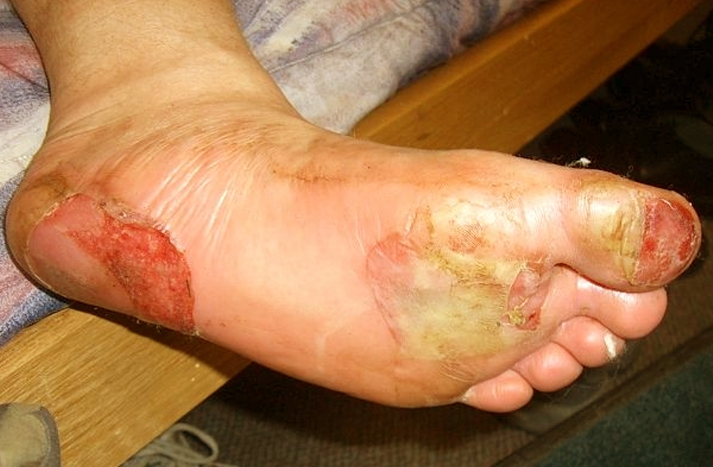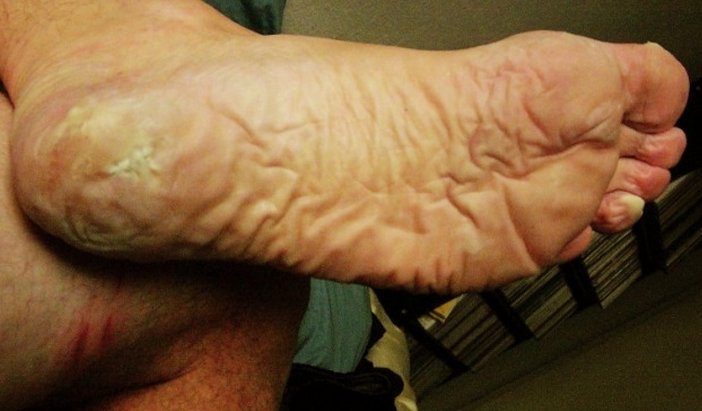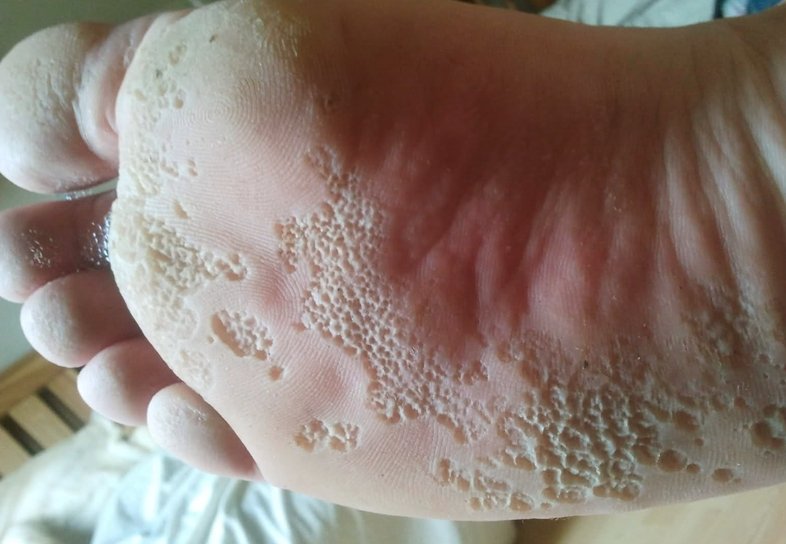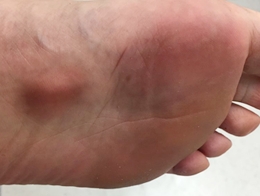Trench Foot
Do you have Trench foot? Get more insights on the symptoms, causes, treatment and home remedies of trench foot.

Do you feel a tingling, loss of feeling, burning sensation or numbness in your foot? You may have mistaken some of those symptoms for conditions like diabetic neuropathy, frostbite or even leprosy. However, trench foot is something quite different from any of those conditions.
You are not the only one suffering from this problem. History reveals that trench foot was first discovered by Napoleon’s army in 1812. Since then, this condition has become an issue that a lot of people have been diagnosed with and go through some excruciating pains before they are lucky to have permanent solution to.
Not to worry, trench foot sure has a solution. That should be good news for you. Isn’t it? The condition could limit you from running for some time, but with time you soon get a cure for it and everything is okay again. There has been so much confusion about the actual cause of this nagging medical condition. And this brings us to the question
What is Trench Foot?
Trench foot otherwise known as Non-freezing cold injury (NFCI) is a medical condition resulting from a long period of exposing the feet to damp, cold and unsanitary conditions. It falls under one of those conditions referred to as immersion syndrome. The disease got its name from the word ‘Trench’ which was used during the World War I.
The condition was common among soldiers during the World War I due to the condition they were daily exposed to in the course of executing the war. The condition resulted from wet feet, especially feet soaked in cold military boots for several hours while hiding out in trenches under unsanitary conditions.
Symptoms of Trench Foot
The signs and symptoms of trench foot include the following:
- Tingling sensation in the foot
- Itching sensation
- Burning sensation
- Numbness
- Loss of feeling
- Cyanosis of the foot
- Numb toes
- Pain
- Prickly or heavy feeling
- Swelling
- Cold, blotchy skin
- Dry and red foot with pain after warming
- Blisters
- Fissures of the skin
- Dying of skin and tissue
- Maceration of the skin can be present.
- Odor from skin necrosis
- Open sores
- Foot may require amputation especially if necrosis sets in
Causes of Trench Foot
Frostbite is known to be caused by extremely cold temperatures. But in the case of the trench foot, the near opposite is the case. The condition can occur in temperature of up to 16⁰c and as few as 13 hours. The mechanism of the injury is not quite clear. Some conditions like excessive sweating, cold, and wet conditions have however, been implicated. Trench foot is not a contagious disease, though secondary infections that can accompany it in some cases can sometimes be.
The infected feet usually become numb, red (as a result of initial increased blood supply to the area following inflammation), cyanotic or bluish due to reduced oxygen supply to the area. As the course of the disease progresses, necrosis (death of surrounding tissues) eventually set in, thereby producing a foul odor. Swelling occurs as well. In the advanced stage, the feet then develop open sores and blisters, giving rise to secondary or fungal infections. At this stage, the condition is referred to as topical ulcer or jungle rot. If no urgent and proper medical treatment is given, gangrene sets in thereby resulting in of the amputation of the affected part. Prompt intervention usually results in quick recovery.
Diagnosis
In trying to diagnose the trench foot, there are other differential diagnoses that need to be made. Since trench foot presents with signs and symptoms similar to what you see in some other disease conditions, there is need to rule out those other conditions. Other conditions to look at include frostnip, pernio, and frostbite.
Frostbite: Frostbite has a few symptoms in common with trench foot. However, while frostbite is caused by exposure to extremely cold weather or moisture, trench foot is not. So, looking at the root cause is one way to diagnose whether it is a frostbite or trench foot.
Pernio (Chilblain or cold sore) presents with symptoms that are less severe than those of the trench foot. Besides, pernio presents with painful inflammatory skin lesions which result from chronic, repeated exposures to damp, non-freezing cold temperatures. The symptoms of pernio include erythema, plaques, edema, nodules, bullae, or vesicles that usually show up as long as after 12 hours of the original injury.
Frostnips present as skin blanching, with temporary numbness and lack of pain (parasthesia). But these usually resolve after re-warming. It usually has no formation of ice crystal in the tissues and there is no tissue loss as well.
Trench foot, however, develops from prolonged exposure to wet, non-freezing cold environment which leads to neurovascular damage around the periphery, without any formation of ice crystal. The nerve damage and blood vessels damage lead to pain, pallor parasthesia (loss of pain sensation), loss of pulse, and paralysis. If diagnosis is made early enough, trench foot can be reversed. The prognosis of the disease is usually better than that of frostbite. So, recovery is faster and better in trench foot than in frostbite.
How to treat Trench Foot
Trench foot can be given symptomatic and holistic treatment. Sometimes, you can look closely at the symptoms presented and then handle them individually to provide some relief for the sufferer. However, it is always best to do a total treatment so that the person can have his peace and comfort. So what are the various ways of taking care of the problem? Don’t worry! That’s why I am here to guide you on what exactly to do to help eliminate all symptoms and bring your feet back to normal function.
Surgery
A surgical procedure known as endoscopic excision of the dorsal root ganglion to create an absence of perspiration (surgical anhydrosis) can be performed. This is achieved by surgically removing the part of the autonomic nervous system that is in charge of perspiration.
Injections
The use of Botox injection can be helpful too in a situation where there is severe sweating. Botox is injected into the smooth muscles which control the sweat glands on the bottom of the foot. This has been used by podiatrists and dermatologists, with very good results.
Anti-inflammatory drugs
They help to relieve pain, slow down inflammation and swelling as well as speed up recovery. A few examples of anti-inflammatory drugs include Naproxen (Aleve), Ibuprofen (Motrin, Advil), etc. However, it must be noted that these drugs are not to be used for too long because of the negative long term effects on the body. It is, therefore, advisable to see the doctor for a better management of the disease.
Antibiotics
Antibiotics may be prescribed by the doctor for the treatment of the primary or secondary infections and to prevent further spread of the infection. Broad spectrum antibiotics or those that can specifically take care of the causative organism should be employed in the management of the condition.
Home Remedies for Trench foot
There are simple interventions you can employ at home to help relieve pain, swelling, excessive sweating, and discomfort. Some of the few things you can do include:
- Clean your feet and dry them thoroughly
- Make sure your socks are thoroughly washed and dried daily. If possible, use some antiseptic lotion to wash them
- Take off your socks when resting or sleeping
- Expose your feet to air at any given opportunity. This will keep it aerated and dry.
- Soak the affected foot or feet in warm water of 102⁰ to 110⁰F for about 5 minutes or apply warm packs to the area.
- Add potassium permanganate solution from your local pharmacy to the warm water for soaking the feet. This helps to draw excess fluid out of the swollen feet.
- Inspect the feet daily and take action the moment you find any anomaly. This is particularly important if there are wounds on the feet that are likely to be infected
- Wear leather or clothes that easily absorb moisture.
- Add another blanket under your feet while sleeping at night. This helps to absorb excess moisture and keep your feet drier.
- Reduce moisture by applying talc or baby powder to the feet regularly.
- Avoid synthetic materials like vinyl or rubber
- Use drying agents for your feet: The most commonly used drying agent to reduce moisture is Aluminium Chloride. The use of Formalin can be helpful to some extent. Moreover, antihistamine and anti-cholinergic are known to play a major role in reducing sweating and moisture accumulation. A few examples are Pro-Banthine, Banthine, and Benadryl.
- Treat signs of infection: Blister formation, pain, color change, and swelling are all signs and symptoms of infection. They need to be treated as early as possible in or order to prevent further spread and complications.
Conclusion
The factors necessary for the development of trench foot include dampness, cold, and unsanitary conditions. If these factors are controlled or completely removed, trench foot can then be effectively prevented.
Pictures of Trench Foot
How does trench foot look like? Take a look at these pictures…








